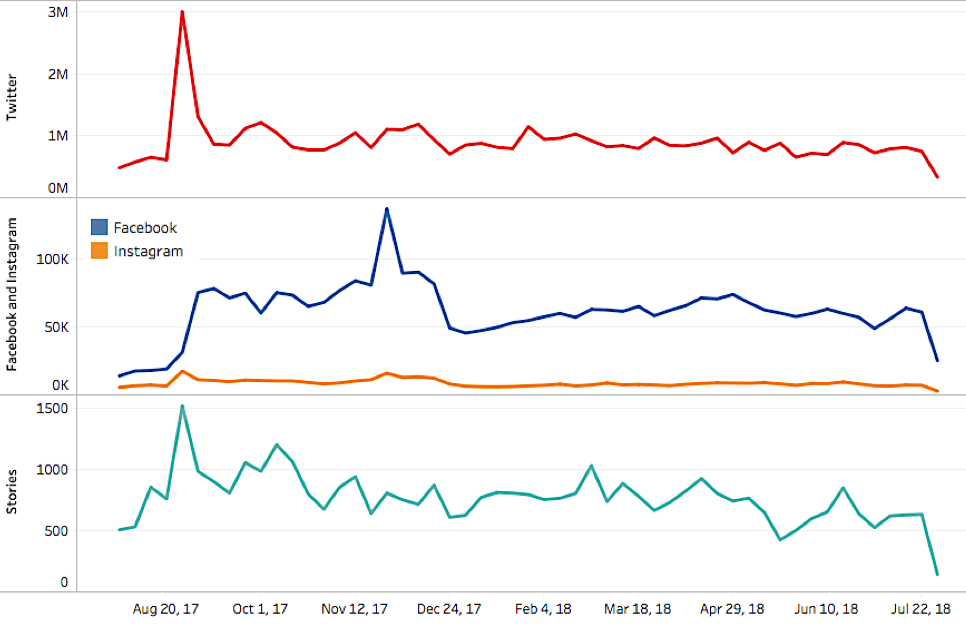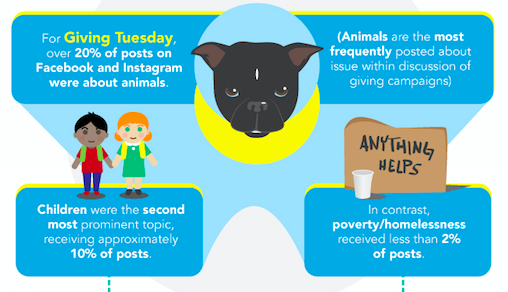Giving and Philanthropy in the US: Analysis of discourse in news and social media
This project sought to analyze and describe the news media and social media discourse surrounding giving and philanthropy in the United States for one year, 8/1/2017 to 8/1/2018. The project was commissioned by the Bill & Melinda Gates Foundation to fill a gap in research describing and understanding conversations around giving and philanthropy that are taking place in the news and across social media in the United States.
Researchers from the MIT Media Lab’s Media Cloud project and the Media Ecosystems Analysis Group collaborated with subject experts at the foundation to develop a complex keyword-based query that would surface content related to giving and philanthropy while reducing unrelated content. Data sources included:
- Media Cloud, an open source news media database developed by Harvard’s Berkman Klein Center for Internet & Society and the Center for Civic Media at the MIT Media Lab. Researchers targeted US publications and the websites these publications were linked to. Over 51K stories from over 6K media sources were collected.
- Crimson Hexagon, a privately-owned platform that collects and analyzes data from Twitter. Researchers targeted Tweets from users in the US. 48M Tweets were collected.
- CrowdTangle, a Facebook-owned platform that provides access to public posts on Facebook and Instagram. This platform does not allow narrowing to a specific country. Over 3M Facebook posts and over 450K Instagram posts were collected.
Who and what drives coverage and discussion?
In the news media, the Washington Post publishes the most content on giving and philanthropy, followed by Forbes, USA Today, the New York Times, and FOX News. Content published by the New York Times received the most Facebook shares. The crowdfunding website GoFundMe.com was the external website most linked to by news media articles.
On social media, philanthropists, nonprofits, and celebrities are the most influential posters on the topic of giving and philanthropy. Philanthropist Strive Masiyiwa had the most liked post on Facebook, detailing his time at the United Nations General Assembly and talking about philanthropy. Singer Selena Gomez had the most liked post on Instagram, referencing her kidney transplant (included in the topic due to donation language). Animal and wildlife charities were influential posters on all social platforms. Influential posters on Instagram in particular tended to be younger singers and actors.
The main events that drove coverage and conversation were Hurricane Harvey (August 2017), the Las Vegas mass shooting (October 2017), and Giving Tuesday (November 2017). The attention-over-time graph below illustrates these spikes in coverage across platforms.

What narratives were present in the discourse?
When describing the impact they were likely to have on a reader’s attitude about giving and philanthropy, narratives were classified as promising, mixed, or problematic. Four sub-narratives within each category were identified:
- Promising narratives, which leave the reader with a positive view of giving and philanthropy and possibly empowering them to donate: the power of crowdfunding, regular people helping in small ways, regular people helping in big ways, donating as part of a healthy lifestyle.
- Mixed narratives, which are heavily context-dependent and for which the impact on the reader is likely to be dictated by the reader’s preexisting political and social views: celebrity charity, corporate donations, philanthropists and their gifts, regular people asking for money.
- Problematic narratives, which leave the reader with a negative view of giving and philanthropy and that foster cynicism about donating: hypocritical donors, untrustworthy charities and fundraising scams, political influence through donations, impact of Tax Cuts and Jobs Act of 2017.
Other findings about discourse on giving and philanthropy
Politics is strongly tied to giving and philanthropy. Although content with the word “election” was removed from the results, political coverage and discussion within the giving and philanthropy results retained a strong presence. The most-mentioned people in news stories were largely political figures: Donald Trump was mentioned in 9% of articles, followed by Barack Obama at 3% and Hillary Clinton at 3%. Bill Clinton, George W. Bush, Mike Pence, Paul Ryan, Bernie Sanders, Mitch McConnell, and Melania Trump were also in the Top 20 of most frequently mentioned individuals. Individuals who tweeted about giving or philanthropy were found to be 16x more interested in conservative politics and 27x more interested in progressive politics than the rest of Twitter users. The hashtag #MAGA was among the top Twitter hashtags used in posts about giving or philanthropy. Finally, politics found its way into discussion and coverage of charity work for disaster relief and other seemingly apolitical causes.

Animal welfare is the most popular issue area. Posts about animal welfare were frequent and among the most popular on all social platforms. When examining a selection of giving campaigns – Giving Tuesday, Red Nose Day, and match giving generally – posts about animals were the most prevalent by a factor of 2x. Posts about animals accounted for 20% of all posts about these giving campaigns, followed by posts about children at 10%. In contrast, posts about poverty or homelessness accounted for less than 2% of the posts in these campaigns.
The Red Cross was the most discussed charity. The Red Cross was the most frequently mentioned charity organization in news media, appearing in 2.4% of stories. No other charity was among the top 20 organizations mentioned in news stories on the topic of giving and philanthropy. On Facebook, the Red Cross blood donations page was the most frequently shared of all news articles or pages linked to by news articles. Finally, the Red Cross was the primary focus of the narrative, Untrustworthy charities and fundraising scams, with news media and social media posters discussing concerns over whether the organization’s resources were being efficiently directed to natural disaster victims.
This research will be repeated in the fall of 2019 to look at the year 8/1/2018 to 8/1/2019. Results will be compared to this initial year of findings and shared.


